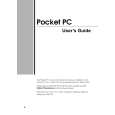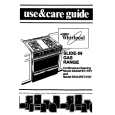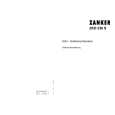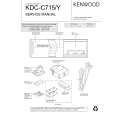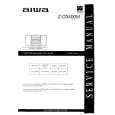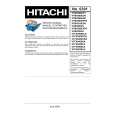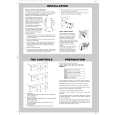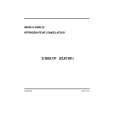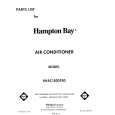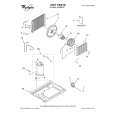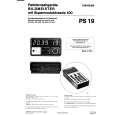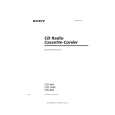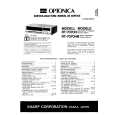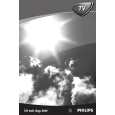|
|
|
Kategorie
|
|
Informacje
|
|
Polecamy
|
|
|
 |
|
|
Dla tego produktu nie napisano jeszcze recenzji!
 ;
Wszystko w porządku.
Instrukcja czytelna i kompletna.
Dziękuję.
all right!
thank you.
 ;
Bardzo dobra instrukcja. Zawiera wszystko co potrzeba, polecam!
 ;
Instrukcja jest OK. Schematy czytelne, opisane niektóre procedury.
 ;
Instrukcja bardzo czytelna. zawiera co potrzeba. Polecam
 ;
...instrukcja serwisowa w pełni czytelna i kompletna. Dziękuję!
EN 106
8.
EM5.1E
Electrical Alignments
5. Use V. SHIFT again to align the test pattern roughly vertically in the middle. 6. Repeat the alignment if necessary. V. S-CORRECTION Align for equal blocks on top, middle, and bottom of the picture tube. Align V. S-CORRECTION such that a block at the top (or bottom) of the picture has the same height as a block in the middle of the picture. H. SHIFT AND H. AMPLITUDE (horizontal alignment) 1. Use H. AMPLITUDE to align the horizontal amplitude so that the entire test pattern is visible. 2. Use H. SHIFT to align the picture horizontally in the middle. 3. Repeat the H. AMPLITUDE alignment if necessary. Note: In case the horizontal linearity in wide-screen mode is out of tolerance, add a "DC-shift correction" panel (3104 328 06230) to connector 1419 of the DAF-panel [diagram I]. On the DC-shift panel, cut diode 6433 for correction to the right or diode 6432 for correction to the left. Caution: Be sure to switch "OFF" the set first. Never plug in a not pre-aligned module in a playing set! EAST/WEST ALIGNMENT 1. Use EAST/WEST PARABOLA to align the vertical lines until straight. 2. Use UPPER EAST/WEST CORNER to align the vertical lines in the upper corners until straight. 3. Use LOWER EAST/WEST CORNER to align the vertical lines in the lower corners until straight. 4. Use EAST/WEST TRAPEZIUM to align for a rectangular. 5. Use HORIZONTAL BOW to correct the E/W parabola such, that it becomes symmetrical. 6. Use HORIZONTAL PARALLELOGRAM to align for straight vertical lines if necessary. Repeat steps 1 to 6 if necessary. 8.3.6 GEO-4:3 (4:3 geometry alignment in 16:9 sets) 1. Use EAST/WEST PARABOLA to align the vertical lines until straight. 2. Use UPPER EAST/WEST CORNER to align the vertical lines in the upper corners until straight. 3. Use LOWER EAST/WEST CORNER to align the vertical lines in the lower corners until straight. 8.3.7 GEO-SW (Super Wide geometry alignment in 16:9 sets) You only need to set the following values (if the normal geometry alignment has been performed correctly): 1. V. S-CORRECTION: enter value of the NORMAL GEOMETRY alignment. 2. H. AMPLITUDE: enter value of the NORMAL GEOMETRY alignment subtracted by "1". 3. EAST/WEST PARABOLA: enter value of the NORMAL GEOMETRY alignment. 8.3.8 GEO-100HZ (Digital Scan geometry alignment) As all alignments are done in Pixel Plus mode (at 75 Hz), the 100 Hz mode needs an extra alignment: � Select GEO-100HZ. The set automatically switches to 100 � � Hz mode. V. SLOPE: match the middle line of the test pattern with the upper edge of this blanking picture. After the alignment, return to the previous menu. The set automatically returns to "Pixel Plus" mode.
1
VERT. SLOPE
2
VERT. SHIFT
3
VERT. AMPLITUDE
4
V.S-CORRECTION
5
HOR. SHIFT
6
HOR. AMPLITUDE
7
E/W PARABOLE
8
UPPER E/W CORNER
9
LOWER E/W CORNER
10
E/W TRAPEZIUM
11
HOR. PARALLELOGRAM
12
HOR. BOW
CL 16532044_022.eps 140501
Figure 8-3 Geometry Alignments Service tip: When the set is equipped with a rotation coil, use this menu item to check its correct alignment. If alignment is not correct, go to the INSTALLATION menu, choose SETUP, press OK, and choose PICTURE TILT. With the use of a crosshatch test pattern, align it to a correct horizontal picture. V. SLOPE Align the zero crossing of the frame deflection to the mechanical middle of the picture tube. 1. First set the start conditions for 16:9 sets: V. SCORRECTION value on "16" for the 28 inch, "32" for the 29 inch, "16" for the 32 inch (LPD - Philips tube), "27" for the 32 inch (MEC - Panasonic tube), or "20" for the 36 inch sets. Position the boundary-stripes of the test pattern on the edges of the picture tube. 2. Align V. SLOPE (during alignment, the lower half of the picture is blanked) such, that the middle line of the test pattern is matched with the edge of the pattern transient in the middle of the picture. 3. Repeat the alignment if necessary. V. SHIFT AND V. AMPLITUDE (vertical alignment) Align the vertical centre and height of the picture. 1. Use V. AMPLITUDE to align the vertical amplitude so that the entire test pattern is visible. 2. Set V. SHIFT to value "32". 3. Connect a voltmeter (V_dc) between R3624 and "hot" ground. 4. Adjust the DC voltage to "0" with potmeter R3642 (see figure 8-1).
|
|
 |
> |
|
